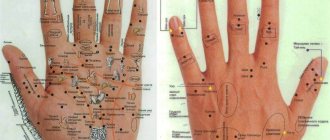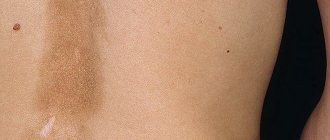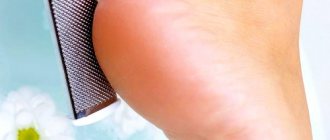The hand is swollen: what to do, what is the reason and how to treat the swelling?
My hand is swollen, what should I do? What is the reason and how to eliminate this annoying phenomenon?!
Edema itself is an accumulation of fluid in the tissues of various organs and limbs, and an increase in the volume of the skin cavity occurs. The cause of edema can be both external and internal factors. In any case, if your hands are swollen, this is a signal that there has been a failure in the functioning of the organs in the body.
Symptoms of hand swelling
If the hand is swollen, then it is easy to notice with the naked eye, simply by comparing it with the hand of another person. As a rule, the process of swelling of the hands begins with swelling of the fingers. You can conduct a mini-test: apply a little pressure on the supposedly swollen tissue; on healthy skin, the imprint will disappear quickly.
Often the swelling of the left hand is much stronger than the right. The reason is that the left arm is less exposed to various loads, and therefore the blood flow in this limb is slower.
Swelling of the hands is usually detected in the morning and disappears during the day. But even in this case, it is worth seeking advice from a specialist. If such a problem is chronic, this indicates serious dysfunction of some internal organ. It is necessary to consult a doctor as soon as possible, even in the complete absence of pain.
Causes of hand swelling
Let's try to get acquainted with the most common reasons why the hands swell.
Poor nutrition
Swelling of the hand can be the result of drinking too much of any liquid shortly before bed. Overeating, drinking alcohol and salty foods can also cause swelling of the limbs. By reviewing your diet and diet, you can easily get rid of this phenomenon.
Pregnancy
Swelling of the hands occurs very often in late pregnancy.
This phenomenon is associated with the occurrence of the so-called tunnel syndrome, when fluid stagnates directly on the wrists, causing impact (pressure) on the nerve, so often with severe swelling, the hands hurt. Following a diet and a healthy lifestyle is the best prevention of edema. But you should still tell your doctor about such problems.
Injury
Bruised hand or broken finger. In this case, inflammation is a natural reaction of the body. It is necessary to apply a cold compress and consult a traumatologist.
Allergic reaction
Hands may become swollen and itchy after contact with various detergents. By eliminating the allergen, the swelling will go away on its own within 24 hours. To alleviate the condition, you can take antihistamines.
Medicine
The swollen appearance of your hands could be a side effect of taking a new medication. It is worth stopping taking the drug and contacting the doctor who prescribed it to you to replace or reduce the dosage.
Kidney disease
For the most part, edema is associated with kidney diseases, because they are responsible for the balance of water in the body. In addition to the hands, other parts of the body may swell. Characterized by general poor health and problems with urination. You should not treat it yourself; serious consequences are possible.
Heart failure
Most of all, swelling at night occurs due to heart failure and deterioration of blood flow. Features of such edema: develop slowly, are symmetrically located, and are accompanied by shortness of breath. As heart failure increases, cardiac edema develops. They start from the feet and rise higher as the disease progresses.
Lung diseases
Swelling of the arms can also be a symptom of the development of lung disease if it is accompanied by enlarged lymph nodes in the armpits. It is extremely important to contact your GP and begin treatment.
Rheumatism
Very often the cause of hand swelling is rheumatism. This is a systemic inflammatory disease of connective tissue, mainly affecting the joints in the body. Clinical picture: the joints of the hands hurt, swelling appears in the affected area, itching, and fingers go numb.
Rheumatism is a very serious and dangerous disease, as it can spread to the skin, internal organs and affect the brain. If you refuse treatment, “rheumatoid” nodules appear on the skin, and joint mobility may be lost.
It is impossible to get rid of the disease completely, but it is very important to start therapy for rheumatism in time and stop its development.
Arthritis
Arthritis of the hands does not only occur in older people; it is characterized by swelling of the hands and severe pain. The cause is usually an infection.
The peculiarity is that the disease develops quickly and leads to loss of hand mobility. The patient loses not only his ability to work, but also the ability to cope independently in everyday life.
The main thing is to consult a doctor in a timely manner and follow the treatment prescribed by him, then the destruction of the joints can be stopped
Arthrosis
An age-related chronic disease characterized by gradual deformation (wear) of cartilage plates. The most common joint disease in the world. Treatment requires an integrated approach, possibly surgical intervention.
Lymphedema
A condition of swelling of the soft tissues of the extremities. It occurs due to a failure in the outflow of fluid through the lymphatic vessels. Symptoms: pain, weakness, limited joint mobility, the skin in the affected area becomes thick and pale.
Treatment
What to do if swelling of your hands prevents you from doing your usual activities? The first thing that is necessary is to find out the reason for this phenomenon. You can do this yourself, but we recommend that you consult a specialist, as you should not underestimate the problem of edema. Before going to the doctor, you can ease your condition a little with the help of the following tips:
- It is necessary to improve blood circulation in the wrist by removing any constrictive jewelry
- Limit liquid intake
- Organize contrasting hand baths
- If your joints hurt, then apply painkillers (such as Voltaren, Diclofenac).
- Do some light exercise. It is recommended to perform them in the evening, a couple of hours before bedtime. Swimming, running, cycling, or, as a last resort, light exercise are best.
Your health is in your hands, so it’s worth taking care of them. There are many reasons for hand swelling, and they are different for everyone. Therefore, entrust the solution to your problem to a specialist who can not only make a correct diagnosis, but also prescribe effective treatment.
Loading…
Source: https://athletic-store.ru/otek/prichiny-i-lechenie-oteka-kisti-ruk
Diagnosis of swelling of fingers
To diagnose and identify the exact cause, you should seek help from a rheumatologist or therapist. The specialist directs the patient to conduct a number of studies:
- X-ray of the hand.
- General blood test.
- If the doctor suspects that the cause is a heart disease, the patient is sent for an ECG.
Causes of swelling of the right hand and treatment methods
Swelling of the hands is a sign that a person has a serious illness. This phenomenon cannot just happen. If the right hand swells, then the reasons for this manifestation may indicate disturbances in the functioning of the liver, heart or kidneys. When a person notices these manifestations on the limbs, one should immediately consult a doctor.
Causes of hand swelling
The main cause of swelling of the right hand is a malfunction of the lymphatic, venous and arterial system of the tissues of the upper extremities.
Also, the appearance of severe swelling in the hands may appear due to the development of pathological processes in the endocrine system and a decrease in protein in the blood due to diseases of the intestines, kidneys and liver. Such phenomena can occur in any pregnant woman.
To increase protein permeability into vital organs, it is necessary to undergo treatment.
Cardiovascular failure
The right side of the heart, for example, is responsible for pumping blood into the vascular system of the lungs from the veins. As a result, gas exchange occurs. If the work in the right side is disrupted, then the blood stagnates in the veins and arteries. All this can lead to heart failure. This pathology can occur due to poisoning, myocardial infarction and heart defects.
The reasons why the right arm swells are sometimes associated with cardiac pathology. The swelling is not pronounced enough. If you feel the swelling on your right hand, it has a dense consistency and does not mix with each other.
Often the reasons why cardiac edema occurs are associated with heart failure. This may include fatigue, shortness of breath and pain in the heart area. If the right arm goes numb and swells, the reasons may be due to the fact that in the evening the heart gets tired and it is difficult for it to pump venous blood from the tissues to the organs.
Injuries
The most common reason why the right hand or palm is swollen is injury, damage or bruise. In this case, the inflammatory process is the body’s reaction to such phenomena. To relieve swelling from the fingers of your right hand, caused by injury, simply apply cold to the injured area of skin.
Allergic reactions
If your right arm is swollen from the elbow to the hand, then this may be due to allergies. If the irritant is detergent or washing powder, then simply replacing it. If it is not possible to avoid contact with the irritant, then you need to wear rubber gloves to prevent your right hand from swelling and swelling. This way you can protect yourself from unpleasant symptoms.
But you can tell by the irritation that it was an allergic reaction that caused the symptoms of swelling of the right hand.
Protein deficiency
Protein molecules play an important role in regulating blood pressure. This pressure helps keep fluid inside the vessels. If a pathology occurs in reducing the required amount of protein, this can lead to negative consequences. As a result, the vessels may not retain water, which is why it leaves the vascular bed.
By nature, small amounts of protein are excreted in urine. If you don't get enough of it from food, it can lead to malfunctions of some organs and swelling of the right hand. Upon visual inspection, the skin will have a pinkish color. But the swelling itself is not dense and will not cause pain.
Kidney disorders
If your right hand is swollen, then the cause may be a problem with the kidneys. When a person drinks a lot of water at night, in the morning you may notice swelling in the upper limbs. In this case, slight swelling of the right arm up to the elbow may go away on its own. You don't need to do anything for this.
If your right arm swells up to the forearm, you should immediately consult a doctor. He will conduct an examination and make the correct diagnosis. If your kidneys are bothering you, then it is important to undergo an examination, and only then engage in treatment.
Joint diseases
The main reasons why the hand and right arm are swollen may be related to joint disease. The inflammatory process can occur as a response of the body to tissue damage.
Pain and swelling of the ulnar and radial veins can occur due to constriction of arterial vessels, which appear with Pancoast cancer, trauma and abnormal development of the arteries.
Lymphedema
If swelling occurs in the tissues of the upper limb, this can cause enlargement of the lymph nodes in the armpit area. All this indicates the presence of pathologies in the functioning of the lungs. The outflow of fluids from tissues is disrupted and this leads to swelling.
If the lymph nodes in the armpit area are enlarged in women, the doctor may send the patient for examination to a mammologist to check the mammary glands for the presence of a cancerous tumor.
Hands swell in the morning
Many people are interested in why their right hand swells in the morning. This can be caused by injuries, fractures, salty foods eaten and water drunk. The right hands also swell when there is an allergy to an internal or external irritant.
If your hand swells before and after sleep due to taking medications, then you should temporarily stop taking them and visit your doctor to change the prescribed medication to another option.
When swelling of the right arm is accompanied by swelling of the eyelids, this may indicate poor liver function.
Indeed, in this case, the organ cannot normally remove toxins from the body, which is why tissue swelling occurs not only in the morning, but also in the evening.
What to do if your hand is swollen
The main methods of treating swelling of the hands are taking medications, which are combined with other conservative treatment methods, including physiotherapy and tight bandaging.
The peculiarity of this therapy is the absence of mechanical damage to tissues.
Surgical treatment is used when it is necessary to correct anatomical disorders or remove pathological processes from organs.
If a bedridden patient experiences swelling of the right arm, drug treatment is often prescribed. The selection of suitable drugs depends on the cause that caused the disease. As a medical treatment, patients may be prescribed certain medications:
- diuretics (Furosemide, Lasix, Diuver);
- hormones (Veroshpiron, Arifon);
- antibacterial agents (St. John's wort, Calendula, Chamomile);
- antihistamines (Diazolin, Tavegil, Zyrtec);
- antiparasitic drugs (Dekaris, Pyrantel).
All these medications are prescribed by the doctor based on the tests performed. You should not self-medicate, as this can lead to deterioration of health. If some medications are not suitable for patients, they can be replaced with other medications.
Surgery
Surgical operations are not the main method for getting rid of swelling of the right hand. They are used in severe cases when drug treatment no longer makes sense.
Surgical treatment is often used to eliminate cysts and tumors in various locations, such as the lungs, kidneys and heartbeat organs. Such space-occupying formations can compress the vessels supplying the upper extremities, affect nerve endings and cause swelling of the extremities.
To understand whether surgical treatment is necessary, you should see a doctor and undergo a series of examinations.
The use of folk remedies
If the right hand swells, then treatment can be carried out using folk remedies. In this case, decoctions and tinctures are excellent, with which you can easily relieve swelling. To remove all excess fluid from the body, you can use the following folk remedies:
- Tincture from the herb “bear ears”. To prepare it you need to put 1 tbsp in one glass of boiling water. l. raw materials. After this, the tincture needs to brew for 4 hours. The prepared consistency should be consumed half a glass in the morning and evening.
- Rosehip decoction. Dry plants also need to be steamed with boiling water, and then drunk in small sips throughout the day.
- Horsetail tincture. In a glass of boiling water you need to put 4 tbsp. l. plants and leave for 2 hours. During the day you need to take the tincture several sips for 2 weeks.
A decoction of anise seeds also helps eliminate swelling in the right hand. Pour a glass of water and 4 tbsp into a container. l. plants. After this, boil the broth over low heat for 7 minutes. You need to drink the prepared liquid three times before meals.
Preventive recommendations
Not many people know why the right hand swells and how to get rid of the swelling. To prevent swelling, you should wear rings and other jewelry that put pressure on your wrists and fingers as little as possible. This improves blood circulation. You should also avoid wearing bags on your elbow, as this can compress blood vessels and lead to blood flow problems.
You should reduce salty and spicy foods in your diet, as well as alcohol. After all, it is these products that lead to the accumulation of water in the body, which leads to swelling of the soft tissues. You should also avoid drinking large amounts of water and dairy products. It is recommended to eat food several hours before bedtime.
If people often notice swelling on their right hand, then they need to include in their diet foods that have a diuretic effect: watermelon, cucumber and viburnum. And when a person works in a stuffy room, it needs to be ventilated regularly, even when the weather is cool outside. To improve muscle tone, you can perform various physical exercises.
Visiting the bathhouse once a week helps to normalize the water balance in the body. You can prevent the appearance of edema with a contrast shower or bath with sea salt. It is important to understand that swelling of the upper extremities does not just appear. Therefore, patients need to undergo examination.
Source: https://OtekOff.ru/otek/otek-ruk/otekaet-pravaya-ruka-prichiny
Measures to prevent the development of edema
You can prevent swelling of your fingers in the morning by following some recommendations:
- remove jewelry from your fingers at night;
- select rings and rings according to size;
- reduce the consumption of salty, hot, spicy foods;
- control the amount of liquid consumed per day.
Monitoring your health status and following the prescribed doctor’s recommendations will help you quickly get rid of swelling and prevent its occurrence in the future.
I write articles in various areas that, to one degree or another, affect such a disease as edema.
Swelling of the right hand: causes and treatment
Swelling of the hands is an alarming symptom. Fluid retention in tissues indicates serious problems in the body. The etiology of this condition may be different. Most often, swelling indicates problems with the heart or kidneys.
However, there are many other diseases that are accompanied by fluid accumulation. Next, we will consider in detail the causes and treatment of swelling of the hands. It is very important to pay attention to accompanying symptoms.
After all, it may indicate a possible disease.
Heart diseases
Edema is one of the symptoms of heart failure. Swelling of the lower extremities is more common. However, as the heart function deteriorates, the patient develops swelling in the hands, face and torso.
Swelling is observed on both limbs and is moderate. A characteristic sign of heart failure is blue discoloration of the skin of the hands (cyanosis). The swollen areas are cold to the touch. This indicates a violation of the blood supply.
Swelling usually occurs in the evening. During the daytime, there is no swelling of the extremities. This is due to the fact that in the evening the heart gets tired and begins to pump blood worse. As a result, congestion occurs in the veins, which leads to swelling in the legs and hands.
Heart failure is not a separate disease. This is a syndrome that occurs in various pathologies: heart defects, coronary artery disease, myocarditis. Edema is accompanied by chest pain, tachycardia, and difficulty breathing.
Vascular disorders
Swelling of the hands may be associated with impaired blood flow and decreased vascular tone. Let us consider such pathologies in more detail.
Superior vena cava syndrome is a consequence of diseases of the chest organs: tumors or cysts of the lung, neoplasms of the thymus gland, inflammation of the mediastinum. As a result of compression of the superior vena cava, stagnation of blood and lymph occurs in the arms, neck and shoulders. This leads to the formation of edema.
With this pathology, swelling occurs not only in both arms, but also in the entire upper body. Patients are worried about a severe cough with shortness of breath, weakness, and fatigue. The skin acquires a bluish tint due to impaired blood supply.
Thrombosis of the subclavian vein can cause swelling in one arm. This disease is otherwise called Paget-Schroetter syndrome. The subclavian vein carries blood from the arms to the superior vena cava. When a vessel is blocked by a blood clot, congestion occurs in the upper extremities. As a result, edema forms due to the accumulation of interstitial fluid.
The cause of this disease is heavy physical work. Due to the strong load on the shoulder girdle, the muscles injure the subclavian vein. This leads to the formation of blood clots.
Swelling usually forms on the arm that is exposed to more stress. There is swelling not only of the hand, but also of the upper limb.
The skin becomes cyanotic, patients complain of aching pain in the injured arm.
Swelling of the hands may be a sign of Steinbrocker syndrome. This condition is a consequence of osteochondrosis of the cervical spine. Due to impaired innervation, the tone of the blood vessels in the hands is disrupted.
With this pathology, slight swelling of the hands occurs. Patients complain of severe pain in the arms and shoulder girdle, which is not relieved by taking analgesics.
The skin of the fingers looks pale and smooth, and sometimes there is a bluish discoloration of the extremities. Numbness of the hands is often noted.
Decreased albumin in the blood
The hands may swell due to a decrease in albumin levels in the blood. These protein substances are responsible for retaining fluid inside the vessels. If the production of albumin decreases, then water comes out and accumulates in the tissues. This leads to the appearance of edema.
A decrease in albumin levels is a sign of the following diseases and conditions:
- Liver pathologies (hepatitis, cirrhosis, cancer). Albumin is produced in hepatocytes. These cells are destroyed in liver pathologies, as a result, protein production decreases.
- Kidney diseases. Normally, albumin should not pass into the urine, since it cannot pass through the kidney filter. With pathologies of the excretory organs, kidney filtration is impaired. As a result, the protein ends up in the urine. In this case, the body loses a large amount of albumin.
- Protein deficiency in food. A lack of protein in the body can occur due to starvation or an overly strict diet. A lack of protein in food leads to decreased production of albumin by the liver.
- Gastrointestinal diseases. Pathologies of the small intestine often lead to inflammation and impaired permeability of its wall. Because of this, proteins from food are poorly absorbed into the blood. This leads to a decrease in the amount of albumin.
Endocrine pathologies
Swelling of the hands is observed in some diseases of the endocrine organs. This may be one of the signs of myxedema. The disease is characterized by a sharp decrease in thyroid function.
The level of hormones thyroxine and triiodothyronine in the blood decreases. These substances are responsible for protein metabolism. With a deficiency of thyroid hormones, the level of proteins in the blood drops.
As a result, proteins accumulate in tissues, which leads to fluid retention and swelling.
The hands most often swell with myxedema. The skin on the affected areas is cold to the touch and dry, often covered with cracks. Hair falls out in areas of swelling. The condition of the nails deteriorates, they become brittle and thinned.
Myxedema is accompanied by bradycardia, low blood pressure, lethargy and drowsiness. Women develop infertility, and men develop impotence. Patients gain weight, experience frequent headaches and dyspeptic symptoms (constipation, nausea, lack of appetite).
Another endocrine cause of edema may be Parhon's syndrome. With this pathology, the hypothalamus produces vasopressin in increased quantities. This hormone is responsible for diuresis. Excessive amounts of vasopressin lead to a sharp decrease in urination. At the same time, excess fluid forms in the body, which leads to edema.
With Parhon's syndrome, swelling appears in the hands, face and legs. The skin has a pink tint. Convulsions, headache, nausea and vomiting are observed.
Lymphatic drainage disorders
Stagnation of lymph is a common cause of edema. Through lymphatic vessels, interstitial fluid leaves organs and tissues. If these vessels become clogged, lymph accumulates and swelling of the hands and other parts of the body occurs.
Impaired lymph outflow is observed in the following pathologies:
- Hand injuries. With hand bruises, the lymphatic vessels are often damaged, which leads to their obstruction.
- Erysipelas. With infectious inflammation of the skin, narrowing and overgrowing of the lumen of the lymphatic vessels sometimes occurs. This leads to stagnation of interstitial fluid.
- Parasitic diseases. Some parasites (filariae) circulate in the lymphatic system. As a result, the lymphatic vessels become clogged with clusters of helminths, which leads to fluid stagnation.
- Conditions after operations. During surgery (especially for fractures), lymphatic vessels are accidentally damaged. This leads to disruption of their patency.
Oncological diseases
Swelling of the hands most often occurs due to a malignant lung tumor (Pancoast cancer). The neoplasm is located under the pleura. As the tumor grows, it compresses the subclavian vein, which leads to disruption of the outflow of blood from the lower extremities.
With this disease, swelling occurs only on one arm. Not only the hand swells, but the entire limb from the shoulder to the fingertips. In severe cases, the face and neck may swell. Swollen skin has a bluish tint, with dilated veins visible underneath.
The tumor compresses not only blood vessels, but also nerves. This causes severe pain and numbness in the swollen hand. The disease is accompanied by deterioration in health: headache, high fever, weakness and weight loss.
Help from traditional medicine
When your hands become swollen and your joints hurt, you can use some traditional methods of treatment:
- Instead of water, it is recommended to drink cucumber pickle; it is advisable to drink two glasses of this drink a day.
- Pumpkin juice is an excellent way to combat hand swelling, but it should be fresh and without sugar.
- Pine decoction will help relieve swelling. To do this, pour pine buds with a glass of water and leave for a couple of hours. After which the broth can be drunk throughout the day in small portions.
- An anti-edema ointment can be prepared at home by mixing milk and honey. To make it have a pleasant smell, you can add sage or lavender to it. Apply the product to your hands for 15 minutes, after which it can be washed off with warm water.
It is important to consider that traditional methods are considered only auxiliary to the main treatment and are more suitable for temporarily relieving the symptom, but not curing the source of the problem itself, so you need to consult a specialist.
Symptoms
A common manifestation of such swelling is swollen fingers. This reason prevents you from putting on the usual ring, and visually it is immediately noticeable. Often the hands also swell, acquiring a very unpresentable appearance that catches the eye. This usually appears in the morning, and a very unpleasant surprise may await you. Even more unpleasant is that the hands do not simply swell, and this is a consequence of some kind of disease or other processes. So treatment in this case is inevitable.
However, you shouldn’t bread it right away either, since normal swelling can go away within hours. But if this continues constantly, then such symptoms cannot be ignored, and it is better to consult a doctor.
What physical procedures are performed for treatment?
Physiotherapy is an additional treatment method for patients with swollen hands. The procedures can only be used during medical or surgical treatment. The main direction of such procedures is that they allow you to dilate blood vessels, accelerate and improve the outflow of lymphatic fluid. When treating swelling of the hands, the following physiotherapy procedures are used:
- Electrophoresis involves injecting medications into affected tissue areas under the influence of an electric field. The method has many advantages. For example, medications may have a better healing effect. But this method will not work if a person has diseased internal organs, since it acts locally.
- Low-frequency magnetic therapy is carried out using magnetic waves and allows you to remove pain and swelling. If your right hand is swollen and the cause is hidden in the lymphatic drainage, then the method will be simply irreplaceable. Magnetic therapy can also be used for injuries of the upper extremities.
- UHF therapy allows you to achieve an anti-inflammatory effect, relax muscles and improve tissue nutrition.
- SUV - irradiation is caused by ultraviolet waves, which have an average length. If a child’s hand is swollen due to injury, then this method may be indispensable, as it has a bactericidal effect.
- Low-intensity SMV therapy is used when there are problems with the thyroid gland or cervical osteochondrosis.
Physiotherapy can be performed as an additional method of treatment to medication. After the doctor determines the cause of the swelling, he will prescribe medications and procedures that will help eliminate the problem.









